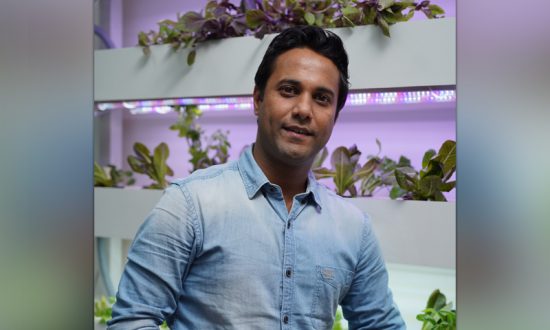An IIM Ahmedabad Alumni with over 10 years of work experience in Business Strategies & Supply Chain Management, Mr. Shivendra, founder Barton Breeze, worked with the Landmark Group in Dubai after graduating from IIM Ahmedabad started working on a pilot project around hydroponics and set up two hydroponic container farms in UAE. With a unique understanding of evolving controlled sustainable technology and modern farming techniques with cross-industry experience, Mr. Shivendra started AI based Hydroponic company with one indoor farm in Dubai and within space of just 3 years has expanded our footprints into 3 countries with more than 200,000 Sq ft of Hydroponic farm, producing more than 900,000 kilos of ‘clean food’ to its customers throughout the year, without being affected by the changing seasons.
The ongoing COVID-19 pandemic raised global concerns on what we are consuming to keep ourselves healthy and fit. It further strengthened people’s sentiments to making nutritious and better quality food available to all at affordable prices and in a sustainable way.
To meet the importing countries demands, India needs to make the most of available technology to produce more while maintaining the quality standards.
About 58% of India’s population’s main source of livelihood is agriculture with the majority of farmers relying on traditional farming techniques. With the growing population and rise in demand for green and healthy vegetables, it’s time to redesign the farming experience.
Agritech, the amalgamation of agriculture and technology, is a modern method to increase yield, quality and profitability. The agritech market has been growing rapidly and is contributing in shaping the future of agriculture industry.
The revamped, next-generation techniques include remote farming, hydroponics, genetic modifications, aerial farming, vertical farming, drone technology, etc. By infusion technology into agriculture, crops are modified so they can grow in any environment, resulting in fast planting and better harvest.
The new technique, remote farming, is done by monitoring and managing farm remotely using mix of Internet of things (IOT), Artificial Intelligence (AI) amongst others. It provides farmers with enhanced technologically equipped apparatus which helps them to produce more with fewer resources available. This makes the farming process more efficient.
Remote farming technique involves IoT, AI, Smart Cameras, Smart Sensors, Climate Control System, Sensor chip in plants and Dashboard Management System (iFarm). The Artificial Intelligence (AI) and data analytics are used to measure vital indicators needed in food planning – supply index, stock availability, local production and consumption levels.
Modern farming methods like hydroponics and aeroponics involve soil-less cultivation in a controlled environment. Plants are grown with nutrient rich solutions for better growth.
According to advance estimates by the government in the Economic Survey 2020-21, GDP contribution by the agriculture sector is likely to be 19.9% in 2020-21, increasing from 17.8% in 2019-20. Further, the farming community’s exceptional endurance amid COVID-19 resulted in agriculture being the only sector to post growth (3.4%) at constant prices in 2020-21, while the entire economy contracted by 7.2%. Currently, the sector is valued at US$ 370 billion and is likely to witness exponential transformation in the future because of supportive government policies and technological advancements. Rising tech awareness among farmers, driven by high internet penetration and mobile connectivity, is expected to drive the sector.
Through the new farming techniques, farmers can now use smart cameras for real-time pest detection and take action against them without affecting the crops. The use of thermal cameras helps farmers in determining and regulating the increase in temperature and water stress condition of crops. Drones are highly cost-efficient as they help farmers react to threats in no time. They help farmers survey the farmland quickly by reporting the crop health, spraying accuracy and monitoring livestock and irrigation systems. The efficient plant sensor chip provides the users with accurate data on plant health — leaf and stem surfaces, water and moisture content, so farmers know the nutrition plants need to grow.
Such smart techniques help farmers relay on critical information that helps in improved crop quality and over all produce. The aim of the smart technology like remote farming is to grow more food in less space with minimum inputs. Agritech assists farmers by saving time and efforts needed during the farming operation and cutting cost.
Remote farming reports are generated by Agronomy Services, Entomology Services, Seeding and Harvesting, Temperature Controls, Farm Automation, Crop Management and Inventory Management.
Farmers largely rely on agritech for its accurate testing methodologies. It efficiently measures food safety in terms of nutritional value, moisture, shelf life, etc. Along with that, it helps in estimating the food quality in terms of external factors like appearance, texture, ripeness, firmness and freshness. AI and IOT used in remote farming help make farmers informed decisions about their crops. It saves time and cost as the users now don’t need to send their produce to labs to get them tested.
Earlier, retailers/farmers used traditional methods to judge the food quality. They used their experience to judge how long will it take for fruits or vegetables to rot, leaving room for inaccuracy.
In Conclusion
Transforming India’s food system is key to attaining zero-hunger goal and the progressive agritech industry looks promising.
931 million tonnes of food go to waste each year worldwide, according to United Nations.
Agritech’s usage of technologies like IOT and blockchain, which cuts out the middlemen, help in reducing waste while tracing the food consumed, thereby, impacting the entire food supply chain.
The expanding agritech market can prove to be a saviour for the country’s suffering farmers. The smart techniques can help the retailers, exporters and farmers to contribute to India’s GDP more than ever before.


